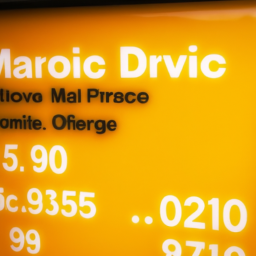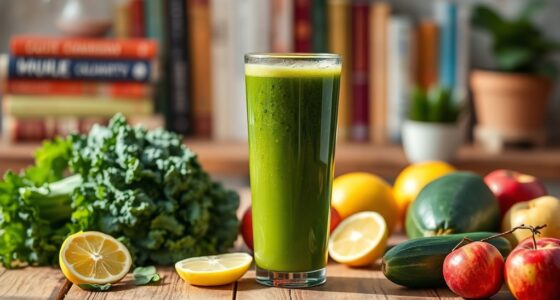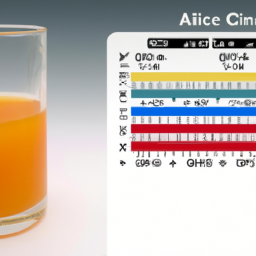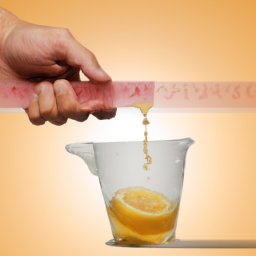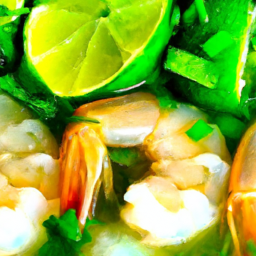I often find myself in the kitchen, contemplating the amount of lime juice needed for a recipe. Lime juice plays a vital role in many dishes, from guacamole to cocktails, and getting the right amount can greatly impact the taste. This prompted me to do some investigating to find out how much juice you can get from one lime.
As it turns out, the amount of juice you can get from a lime depends on several factors, such as the ripeness of the fruit and your juicing technique. Understanding these factors can help you get the most out of your limes and ensure that your dishes are bursting with flavor.
In this article, I’ll be sharing my findings on how much juice you can expect from one lime, as well as tips for selecting and juicing the best limes for your recipes. So, let’s get started!
Key Takeaways
- One lime can produce about 1-2 tablespoons of juice, depending on its size and ripeness.
- The ripeness and temperature of the lime can affect its juice yield.
- Rolling the lime before juicing and microwaving it for 15 seconds can help extract more juice.
- A citrus reamer or juicer can be used to get the most juice out of the lime.
Understanding the Importance of Lime Juice in Recipes
You’re probably wondering why lime juice is such a crucial ingredient in so many recipes. Well, let me tell you, it brings a tangy and bright flavor that can take a dish from mediocre to exceptional in just a squeeze.
The benefits of lime juice go beyond its taste, as it also has health benefits. Lime juice is rich in vitamin C, which boosts the immune system, helps with digestion, and even promotes healthy skin.
However, if you don’t have lime juice on hand, there are alternatives you can use. Lemon juice is a common substitute that can provide a similar tangy flavor, while vinegar can add some acidity. However, keep in mind that these alternatives may not have the same distinct flavor profile as lime juice, and using them may require adjusting other ingredients in the recipe.
With that being said, now let’s move on to the factors that affect lime juice yield.
Factors that Affect Lime Juice Yield
There are certain factors that can impact how much liquid you get when squeezing a lime. One of the most important factors is the lime juice acidity. The higher the acidity of the lime, the more juice it will produce. This is because the acidic environment helps to break down the cell walls of the lime, making it easier to extract the juice.
Another factor that affects lime juice yield is the ripeness of the lime. A ripe lime will generally have a higher juice yield than an unripe one. This is because a ripe lime has more juice-filled vesicles in its pulp, which are easier to extract.
Additionally, the temperature of the lime can also affect how much juice it produces. A warm lime will generally yield more juice than a cold one.
With these factors in mind, it’s important to understand how to optimize lime juice extraction to get the most out of your limes.
Now, let’s move on to discussing the average amount of juice you can expect to get from one lime.
Average Amount of Juice from One Lime
Getting the perfect amount of lime juice for your recipe can be tricky, but understanding the average yield from a single lime can help you plan accordingly. On average, one lime can produce about 1-2 tablespoons of juice, depending on its size and ripeness. This may not seem like a lot, but keep in mind that lime juice has a strong flavor and can easily overpower a dish if too much is used.
If you find yourself in a pinch and don’t have fresh limes on hand, there are several lime juice alternatives that can be used in a recipe, such as bottled lime juice or even lemon juice. However, it’s important to note that fresh lime juice provides the most health benefits.
Lime juice contains high amounts of vitamin C and antioxidants, which can boost your immune system and may even prevent certain types of cancer. To determine the ripeness of a lime, there are a few key indicators to look for. But before we dive into that, let’s first understand why the ripeness of a lime matters.
How to Determine the Ripeness of a Lime
If you’re looking to add a zesty kick to your dish, picking a ripe lime is as important as a bee finding a flower with nectar. The ripeness of a lime can significantly affect the amount of juice you can get from it, as well as its flavor and aroma. So, how can you determine if a lime is ripe? Here are some tips.
Firstly, check the color of the lime. A ripe lime should be bright green or slightly yellowish. Avoid limes that are too green or too yellow as they may not be ripe yet or overripe.
Secondly, give the lime a gentle squeeze. A ripe lime should be slightly soft and give a little when pressed. If it’s too hard, it may not be ripe yet, and if it’s too soft, it may be overripe.
Finally, smell the lime. A ripe lime should have a fresh and fragrant scent. Uses for ripe limes include making lime juice, adding zest to dishes, and even making lime-infused water. To extend the life of a lime, store it in the refrigerator or in a cool, dry place.
When it comes to selecting the best limes for juicing, there are a few additional steps to take. Look for limes that are heavy for their size and have smooth, firm skin. Avoid limes that are wrinkled, have blemishes, or feel too soft. By selecting the right limes, you can ensure that you get the most juice out of them and add the perfect touch of citrus flavor to your dishes.
How to Select the Best Limes for Juicing
To ensure maximum flavor and yield from your lime juice, it’s important to carefully select limes that are heavy, smooth, and firm. The best suppliers for limes are local farmers’ markets or specialty grocery stores that sell organic produce. These suppliers tend to have fresher and higher quality limes compared to regular supermarkets.
Additionally, it’s important to check for any blemishes or soft spots on the lime as this could indicate that the fruit is overripe and will not yield as much juice.
If limes are not readily available or if they’re not in season, there are alternative citrus fruits that can be used for juicing. Lemons and oranges are great substitutes for limes and can still provide a similar flavor to your dishes. However, it’s important to note that the acidity and sweetness levels may differ from lime juice, so it’s best to adjust the measurements accordingly.
With the right selection of limes or alternative citrus fruits, you can ensure that your lime juice is bursting with flavor and ready to be used for your favorite recipes.
When it comes to getting the most juice out of a lime, there are a few tips that can be helpful.
Tips for Getting the Most Juice out of a Lime
After selecting the best limes for juicing, it’s important to know how to get the most juice out of them. Here are some tips I’ve learned over the years:
- Roll the lime on a hard surface before juicing to break down the membranes inside and release more juice.
- Microwave the lime for 15 seconds to warm it up and make it easier to juice.
- Cut the lime lengthwise instead of crosswise to expose more juice-filled membranes.
- Use a citrus reamer or juicer to get the most juice out of the lime.
But even with these tips, sometimes it can be difficult to get as much juice as you need from just one lime.
In these cases, there are alternative squeezing methods you can try, such as using a fork or tongs to press and twist the lime against a juicing cone. You can also use lime zest to add extra flavor to your dish or drink, which can be grated off even after the lime has been squeezed.
When you’re finished juicing your limes, you may have some leftover juice. But how do you store it to keep it fresh?
How to Store Leftover Lime Juice
Properly storing leftover lime juice is key to avoiding waste and ensuring freshness lasts. There are various storing techniques and preservation methods that can help extend the shelf life of leftover lime juice. One of the most common ways to store leftover lime juice is by using an airtight container. This can be a glass jar with a tight-fitting lid or a plastic container with a snap-on lid. It is important to make sure that the container is completely sealed to prevent the juice from getting exposed to air, which can cause it to spoil faster.
Another way to store leftover lime juice is by freezing it. This can be done by pouring the juice into ice cube trays and freezing them. Once the cubes are frozen, they can be transferred into a resealable plastic bag and kept in the freezer for up to six months. This method ensures that the lime juice stays fresh and can be used whenever needed. Properly storing leftover lime juice allows for easy access to it when needed and can help save money and avoid waste. Speaking of which, let’s move on to some common recipes that call for lime juice.
Common Recipes that Call for Lime Juice
You’ll love adding a zesty kick to your dishes with these common recipes that just wouldn’t be complete without a splash of lime. Lime juice is a versatile ingredient that can be used in many dishes, from savory to sweet.
Some creative uses of lime juice include adding it to marinades for meats, using it as a dressing for salads, or mixing it into cocktails for a refreshing twist. Not only does lime juice add flavor to your dishes, but it also has health benefits.
Lime juice is high in vitamin C, which can boost your immune system and improve your skin health. It also contains antioxidants that can help fight inflammation and prevent chronic diseases. So, the next time you’re looking to add some zest to your meal, reach for a lime and enjoy the added health benefits.
Now, let’s move on to learning about conversions for lime juice in recipes.
Conversions for Lime Juice in Recipes
Don’t be afraid to go crazy with the tangy flavor of lime in your recipes by using it in generous amounts – your taste buds will thank you!
But before you squeeze that lime, it’s important to know how much juice you’re actually getting from it. One average lime typically yields around 1-2 tablespoons of juice, depending on its size and juiciness. To get the most out of your lime, try gently rolling it between your hand and a hard surface before juicing it.
If you don’t have any limes on hand, don’t worry! There are alternative citrus options that can give your recipes a similar tangy flavor. For example, lemons, oranges, and grapefruits can all be used as substitutes for lime juice. Just keep in mind that each citrus fruit has its own unique flavor profile, so adjust the amount of juice accordingly.
And when measuring lime juice accurately, it’s always a good idea to use a measuring spoon or a juicer to get consistent results in your recipes.
Frequently Asked Questions
Can I substitute bottled lime juice for fresh lime juice in a recipe?
I’ve successfully substituted bottled lime juice for fresh lime juice in recipes before, but it can alter the taste slightly. Be sure to use the same amount called for and adjust to your liking.
What are the health benefits of lime juice?
I’m excited to share the many uses of lime juice, including its impressive nutritional value. From aiding digestion to boosting immunity, this zesty citrus fruit packs a punch. Let’s dive into the health benefits of lime juice!
How long can I keep fresh lime juice in the refrigerator?
I usually store fresh lime juice in an airtight container in the refrigerator for up to 2 weeks. To maximize its shelf life, I avoid exposing it to air and light. I use lime juice in various recipes such as marinades, dressings, and cocktails.
Is it necessary to use a specific type of juicer for limes?
I’ve found that using a handheld citrus press works best for lime juice extraction. It’s quick and efficient, and helps to avoid any bitter taste from the skin. Experiment with different juicing techniques to find what works for you.
Can I freeze leftover lime juice for later use?
I’ve discovered that you can freeze leftover lime juice for later use. Simply pour the juice into an ice cube tray and freeze. This is a great way for lime juice preservation and to always have fresh juice on hand.
Conclusion
Well, folks, we’ve come to the end of our journey to uncover the mysteries of lime juice. Who knew that such a small citrus fruit could cause so much confusion?
But fear not, for now we have the knowledge to confidently squeeze our limes and add that tart goodness to our favorite recipes. But let’s not get too ahead of ourselves. We must always remember the importance of selecting the perfect lime, and using the correct techniques to get the most juice out of it.
Because, let’s face it, no one wants to waste precious lime juice, especially when it costs a whole 25 cents per lime (I mean, that’s practically a fortune, am I right?).
So, let’s raise our lime juicers high and toast to the power of lime juice in our culinary adventures. Cheers!
Ilana has been a vegan for over 10 years. She originally made the switch for health reasons, but soon found herself becoming more and more passionate about the ethical and environmental implications of a vegan lifestyle. Ilana is the author of The Graceful Kitchen, a blog all about veganism. She loves to cook up delicious and nutritious vegan meals, and share her recipes with others who are interested in leading a cruelty-free life. Ilana is also a strong advocate for using whole foods as the foundation of a healthy diet, and believes that going vegan is one of the best ways to achieve this.

